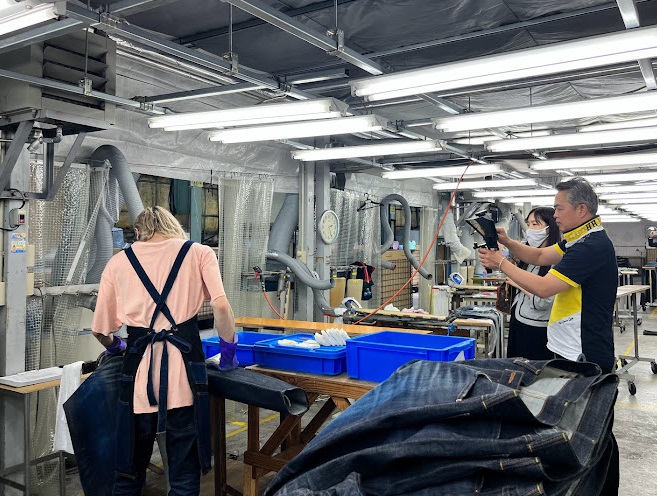実施日 : 2023年06月20日(火) - 21日(水)
Report: Kurashiki & Kagawa Press Tour
投稿日 : 2023年07月12日
On the occasion of the G7 Kurashiki Labour and Employment Ministers' Meeting and the G7 Sustainable Urban Development Ministers' Meeting in Takamatsu, Kagawa, this press tour was held to promote the attractions of Kagawa Prefecture and Kurashiki, Okayama overseas. In Kurashiki, the tour visited the Kojima district, home to the Kurashiki Bikan Historical District and many jeans businesses, to cover sustainable urban development and manufacturing. In Kagawa, the tour visited soy sauce and olive businesses in Shodoshima, where efforts for cyclical agriculture are progressing in its food industry. A total of eight journalists participated in this tour, from media organizations based out of China, France, Germany, Hong Kong, and Türkiye.
*This tour was sponsored by Kurashiki City and the Promotion Council for the G7 Sustainable Urban Development Ministers' Meeting in Takamatsu, Kagawa, and organized and operated by the FPCJ.
*For more details on the tour stops, see the tour notice.
[Day 1] Kurashiki, Okayama
<Kurashiki Bikan Historical Quarter>
The journalists first listened to a briefing by a Kurashiki City official about the development of the textile industry in Kurashiki and initiatives to preserve the city’s scenery. The tour then went to Kurabo Memorial Hall, taking photos and videos of the numerous traditional buildings remaining in the Bikan Historical Quarter. At Kurabo Memorial Hall, they learned about the major contributions Magozaburo Ohara made to the development of Kurashiki’s textile industry. The tour also visited Kurashiki Sola, where a hospital built over one hundred years ago was renovated as a complex with restaurants, clothing stores, and accommodation, as part of Kurashiki’s efforts to preserve the townscape.
 |
 |
After lunch, the journalists went to Kojima, Kurashiki, the mecca for domestic Japanese jeans, and first visited Howa, a long-standing jean dyeing and washing business. They watched a video and heard from company president Mr. Takehisa Tashiro about the company’s history and the techniques it has developed, before touring the workshop. The journalists showed great interest as they filmed and photographed the completely automated robot shaving process and processing by artisans. They asked a number of questions, about strategies for differentiating Howa from foreign competitors, environmentally-friendly washing and processing techniques, and branch locations in Japan and abroad.
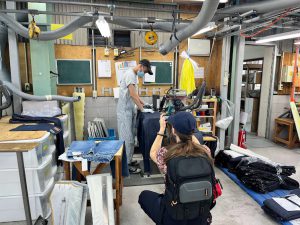 |
 |
 |
 |
At TCB Jeans & Co., the tour heard from company president Mr. Hajime Inoue about his background, what led to establishing the TCB Jeans brand, and an overview of the company. The group then looked around the store and the sewing factory, interviewing employees and taking many photos and videos of the factory. The journalists asked Mr. Inoue about jean designs, the general age of the company’s customers, overseas markets, and why he likes jeans.
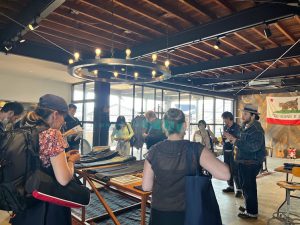 |
 |
 |
 |
<Kojima Jeans Street & Big John Kojima Store>
To end the first day, the tour visited Kojima Jean Street, a street around 400 meters long with about 40 stores selling Kojima jeans lining it, and heard about the street from Mr. Nobuichi Dazai, the senior managing director of the Kojima Chamber of Commerce and Industry, who was involved in starting the Kojima Jeans Street project. Next, PR staff for Big John, the pioneering business that was the first to make domestic Japanese jeans, showed the tour the first pair of jeans made in Japan and told them about the history of the company. The journalists split up to do what they were interested in, taking photos and videos of the store and Jean Street or holding interviews. They asked questions about what role Big John played in the revitalization of Kojima, its differences from other companies, and why jeans have been beloved for so long.
 |
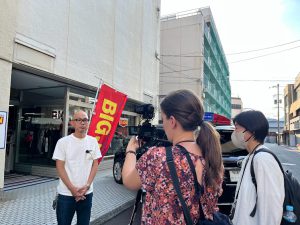 |
 |
[Day 2] Shodo Island, Kagawa Prefecture
The tour took an early morning ferry to Shodo Island and visited Yamaroku Shoyu, which makes its soy sauce using traditional methods, preparing it in wooden barrels. The journalists showed great interest in the explanation from company president Mr. Yasuo Yamamoto about the history of making soy sauce in wooden barrels, how it is made, and other traditional Japanese fermented condiments. They asked numerous questions about the company’s operations and total output, strategies for expanding overseas sales routes, and government support for preserving the tradition of soy sauce made with wooden barrels. After the interview, the journalists took many photos and videos of wooden barrels used to make soy sauce for over 150 years.
 |
 |
Next, the tour visited the greenhouses of Mr. Kazushi Takemoto, who has been growing vegetables (mainly tomatoes) using soy sauce lees as fertilizer since 2014. Mr. Takemoto explained why he decided to grow hishio (soy sauce) vegetables using soy sauce lees, and what unique characteristics the lees give the vegetables. The journalists tried the tomatoes, and were surprised at how sweet they were. They asked many questions, about why using soy sauce lees with high salt content as fertilizer made the tomatoes sweeter, what vegetables other than tomatoes were appropriate for this growing method, and whether there were other fertilizers he used.
 |
 |
In the afternoon, the tour covered olives, which Shodo Island is known for. First, the group visited Shodoshima Olive Park and heard an overview of the park and the history of growing olives on Shodo Island from Mr. Hiroshi Shiro, an executive director of the park. Despite some light rainfall, the journalists actively took numerous photos and videos of the park, including its olive fields.
<Interview with Shodoshima Mayor Mr. Masahiko Oe>
 The journalists heard from Mr. Masahiko Oe, the mayor of Shodoshima, about municipal policies such as initiatives for restoring the tourism and food industries that form the base of the town’s industries, and strengthening the foundations for employment. The journalists asked questions about how Shodoshima in particular managed to continue to prosper from growing olives even when they are grown in other areas as well, support from the municipal government for the olive industry, training workers, and welcoming foreigners.
The journalists heard from Mr. Masahiko Oe, the mayor of Shodoshima, about municipal policies such as initiatives for restoring the tourism and food industries that form the base of the town’s industries, and strengthening the foundations for employment. The journalists asked questions about how Shodoshima in particular managed to continue to prosper from growing olives even when they are grown in other areas as well, support from the municipal government for the olive industry, training workers, and welcoming foreigners.
The journalists visited the factory of Agri Olive Shodoshima, a business contributing to cyclical olive agriculture. The company makes livestock feed and fertilizer from the olive dregs left after extracting olive oil, as part of an effort to contribute to cyclical agriculture. The journalists showed great interest while listening to how olives are used to grow olives in an agricultural cycle, including using olive fertilizer to prepare the soil for the next olive harvest, and about the characteristics of olive livestock feed. They asked questions about what led to deciding to use olive as feed, whether the prefectural government provided any support, sales routes, and future plans for expansion.
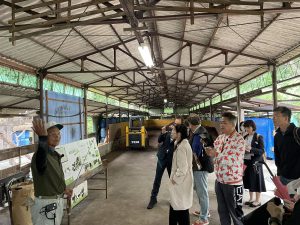 |
 |
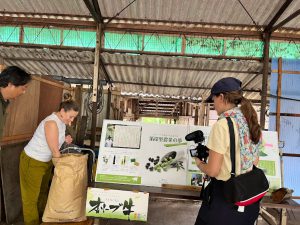 |
<Kagawa Prefecture Brand Beef, Olive-fed Wagyu Beef>
The last stop on the tour was to cover the Kagawa Prefecture brand of olive-fed wagyu beef. The tour visited the cattle barn of Mr. Masaki Ishii, known as the creator of olive-fed wagyu beef, and heard from him about what led to creating olive-fed wagyu beef, how the flavor of the meat changes due to olive feed, and the characteristics of olive-fed wagyu beef. As it continued to rain, the journalists interviewed Mr. Ishii and took photos and videos of the barn.
 |
 |
◆Below is some of the reporting based on this tour.
Dot Dot News (點新聞) (Hong Kong)
"日本少年鍾愛牛仔 移居聖地兒島建牛仔工廠" (June 28)
"傳統的,也是最好的——訪「木桶釀造」醬油" (June 29)
"醬油大國的食材創新——日本培植「醬番茄」受食客好評" (June 30)
"(多圖)橄欖油充分再利用 日本小豆島發展循環型農業" (June 30)
东南网 (China)
"探访“日本国产牛仔裤发源地”——冈山县仓敷市儿岛" (June 28)
"日本冈山县仓敷市:白墙、绿柳与蓝天" (June 28)
"日本仓敷市儿岛牛仔裤工厂的新老势力"」 (June 30)
"坚持传统之味——访日本“木桶酿造”酱油工厂" (June 30)
"以橄榄为中心的循环农业与观光经济——日本香川县小豆岛" (July 1)
"日本香川县小豆岛:创新西红柿种植 增添农业新活力" (July 1)
DW(Deutsche Welle) (Germany)
"Japan's luxury olive oil industry embraces organic farming" (June 29)

